I usually bring sandals to wear around camp when on backpacking trips. But, when backpacking cold and wet weather, the sandals simply don’t cut it. My feet would end up cold and wet.
Sure, I could just wear my normal hiking boots around camp. But, aside from the fact that I like to let my feet air out after a long day of hiking, there’s the issue of those inevitable nighttime trips to go pee. As one backpacker commented,
Once I’ve got dry socks on, I don’t want to take them off and slip on frozen shoes just to go to the bathroom or walk across my campsite.
Luckily, there are a lot of good solutions for keeping your feet warm and dry as you walk around camp, even in mud, snow or really cold conditions. Here are the best options, including some ultralight camp shoes and booties which don’t cost a fortune.
Option 1: Camp Booties with Soles

From L to R: Baffin Base Camp, The North Face Thermoball booties and Acorn Slouch Boots
Verdict: Terrible in wet or muddy conditions. Good for powdery snow or your sure the conditions will be dry – but make sure you get a booties with a thick sole and good tread.
Most “camp booties” are meant to be worn as socks: they are NOT meant to be worn outside. But there are some camp booties which have soles, so you can wear them outside around camp too.
The problem is that camp booties are not waterproof. Sure, the “water-resistant” fabric might hold up against morning dew. It’s usually good for walking around in powdery snowy too. But you are completely screwed if it rains or is really muddy.
Another issue is that the soles rarely have good tread on them – you can easily slip trying to walk around on wet rocks, etc. The booties with good tread will weigh more, so forget about ultralight options.
And yet another downside? Since you are walking around outside, the booties will get dirty – which means you can’t wear these same booties as pajama socks in your sleeping bag.
Below are some of the best camp booties. They all have soles with decent tread.
- Western Mountaineering Expedition Booties: Down with water-resistant shell. They go up to your knees. Great for snowy conditions. But very EXPENSIVE!
- Baffin Base Camp Bootie: These are great for powdery snow but definitely not for wet or rocky conditions. They have a 60D nylon upper, 400g wadding insulation inside, and the footbed is 1000D nylon with silicone slip resistant print. The large size weighs around 8oz for the pair.
- The North Face ThermoBall Traction Booties: These are synthetic booties with a water-resistant finish. The rubber soles have excellent tread. Not for rainy or really wet conditions though, and a bit heavy (around 16oz for the pair). There are men’s and women’s versions.
- Dearfoams women’s bootie slippers: This brand makes a lot of really nice, warm booties out of wool and synthetics. They are fairly heavy but comfy and have very tough soles that can handle rocks. The “sidewalls” mean they can handle some wet conditions.
- Acorn Slouch Boots: These are basically wool/synthetic socks with a rubber sole. They are made to be worn outside and have a sidewall so can withstand some amount of muddy or rainy weather. They are pretty lightweight and come in men’s and women’s sizes.
2. Waterproof Over-Boots + Booties
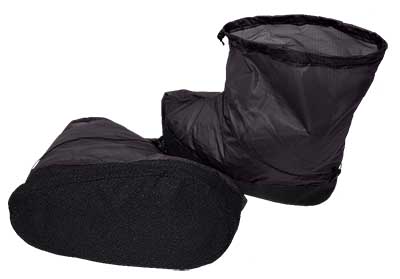
Goosefeet Gear over-bootie, meant to be worn over their down booties
Verdict: Best all-around solution, but camping over-boots can be really expensive and there aren’t many options!
Over-boots (aka over booties) are basically a shell layer for your down or synthetic bootie. They ideally should be made out of a completely waterproof material and have a good non-slip sole.
This solution is great because you can wear whatever insulating bootie you want. Put the bootie on when walking around camp and then just slip it off when it’s time to get into the tent. Since the over-bootie keeps the bootie clean and dry, you can wear the booties for sleeping (obviously not ideal if they get sweaty from walking around camp though).
The only issue is that there aren’t many options for waterproof over-booties. Goosefeet Gear makes some good ones. They have two sole options: thinner but lighter (2oz in medium size) or thicker but rugged (4.5oz in medium size). You can get them here.
3. Waterproof Shoe Covers + Insulating Layer
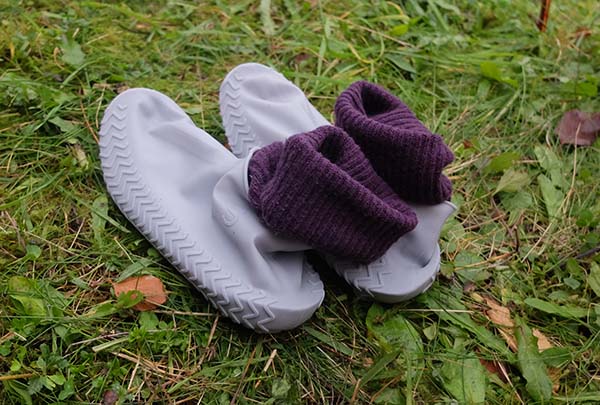
The slippers I made out of silicone shoe covers + old insoles + wool socks
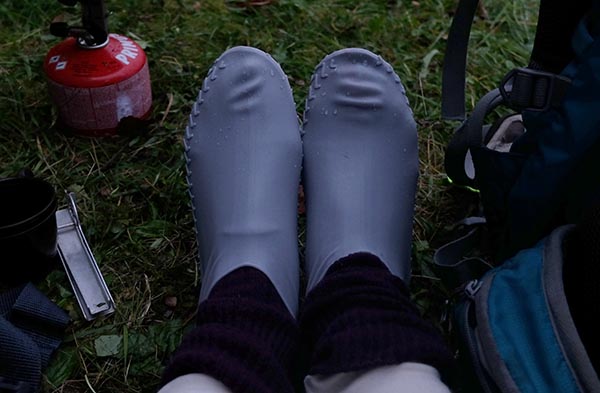
Here’s what they looked like on my feet. It was raining and they kept my feet dry.
Verdict: Cheap solution which works with lots of socks and booties, but cheap covers won’t hold up long and they are hard to size correctly.
Instead of getting camp over-booties (they are pricy!), you can just get some cheap waterproof shoe covers instead. There are tons of options.
For example, I got some silicone shoe covers for rain (like these). The biggest problem was that they don’t have a sole: my feet would get cold walking on the cold ground. So, I put an old pair of insoles inside of them. Then I wore them over my wool socks. This was perfect for camping in rainy October weather. It wouldn’t be warm enough for snow though.
These “camp shoes” weighed just 3.5oz (plus the weight of my wool socks, which I wear when sleeping anyway) and cost under $10.
Other solutions include:
- Wearing sandwich bags over your booties: You can’t really get cheaper or lighter than sandwich bags – but the bags will quickly tear.
- Contractor shoe covers (like these): These probably don’t fit well and your feet will slide around in them, but they are very cheap and lightweight.
- Waterproof overshoes (like these): These are durable and have a sole, but are usually heavy. Also, they are meant to be worn on boots, not over booties or socks, so it’s hard to get a good fit.
![]()
4. Waterproof Shoes
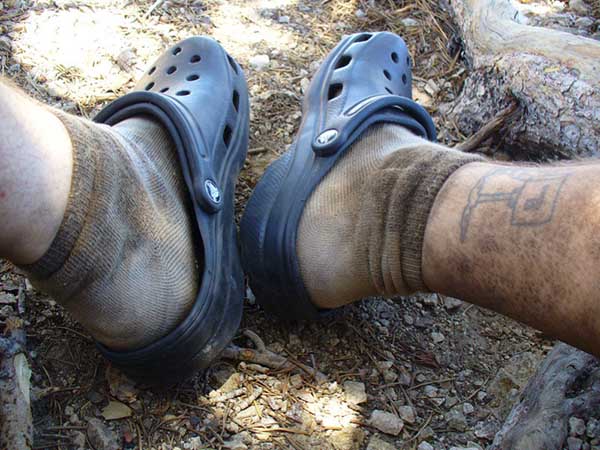
Filthy feet in Crocs on the PCT
Verdict: Cheap and easy solution, but most waterproof shoes are heavy and not very packable.
Another solution is to just get some waterproof shoes to wear around camp. Crocs seem to be the most popular option. There are Crocs without holes and ones which are lined with fleece to keep your feet warm.
Crocs definitely are comfy and hold up on rocky terrain. But they are heavy and really bulky. I’ve heard of people using swim shoes as camp shoes, but those are usually water-resistant and not actually waterproof Also, if things were to get really wet or muddy, your feet would likely end up getting wet -though you could wear them with a waterproof sock like Seal Skinz.
5. Warm Sock + Something to Line the Inside Of your Boot
If you don’t mind wearing your boots around camp, then here’s a simple solution:
- Bring something to line the inside of your boot. Bread bags work well. So do Reynolds oven bags.
- When you get to camp, take off your boots. Loosen the laces. You may need to remove your insole too.
- Put your liners inside the boots.
- Now put on your warm, dry camp socks and slide them into the lined boots. Even if your boots are completely wet, your feet will stay dry.
Would I prefer to let my feet air out after a long day of hiking? Yes. But this solution is stupidly cheap and really ultralight.
Got any better solutions for cold-weather camp shoes and booties? Let us know in the comments below.
Sources:
https://www.reddit.com/r/WildernessBackpacking/comments/trvcvm/everyones_favorite_cold_weather_camp_shoe_system/
https://www.reddit.com/r/WildernessBackpacking/comments/erkl0c/camp_shoes_for_winter_backpacking/ https://www.reddit.com/r/Ultralight/comments/df8bmj/best_camp_shoes_for_cold_weather/
http://www.wilderness-survival.net/forums/showthread.php?21722-My-advice-on-winter-camping-footwear-and-cold-feet-(part-1-of-2)-Long https://www.rokslide.com/forums/threads/camp-shoe-in-the-snow.205839/
Image credits: “Tips for Winter Camping.” (CC BY 2.0) by vastateparksstaff,
“PCT SoCal008.JPG” (CC BY-NC-ND 2.0) by rjtrick


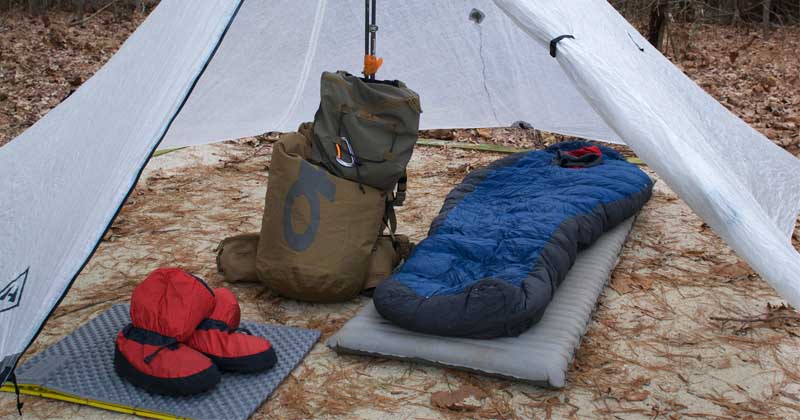

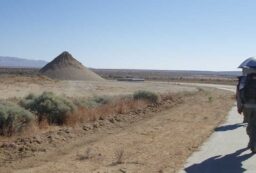








Post your comments